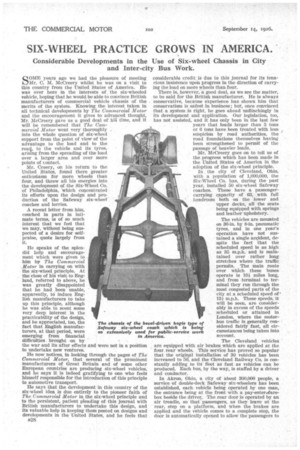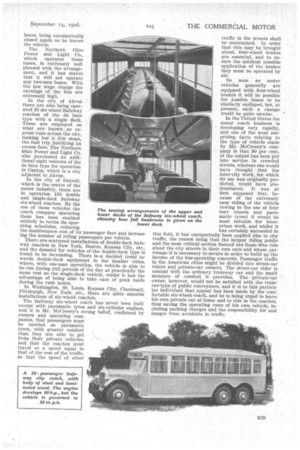SIX-WHEEL PRACTICE GROWS IN AMERICA.
Page 46

Page 47

Page 48

If you've noticed an error in this article please click here to report it so we can fix it.
Considerable Developments in the Use of Six-wheel Chassis in City and Inter-city Bus Work.
S°MF1years ago we had the pleasure of meeting Mr. C. M. MeCreery whilst he was on a visit to this country from the United States of America. He was over here in the interests of the six-wheeled vehicle, hoping that he would be able to convince British manufacturers of commercial vehicle chassis of the merits of the system. Knowing the interest taken in all technical developments by The Commercial Motor and the encouragement it gives to advanced thought, Mr. McCreery, gave us a good deal of his time, and it will• be remembered that The Commercial Motor went very thoroughly
into the whole question of six-wheel support from the point of view of the advantage to the load and to the roag, to the vehicle and its tyres, arising from the spreading of the load over a larger area and over more points of contact.
Mr. Creery, an his return to the United States, found there greater enthusiasm for more wheels than four, and threw all his energies into . the development of the Six-Wheel Co. of Philadelphia, which concentrated its efforts upon the design and production of the Safeway six-wheel coaches and lorries.
A recent letter from him, couched in parts in intimate terms, is of so much interest that we feel that we may, without being suspected of a desire for selfpraise, quote largely from it.
He speaks of the splendid help and encouragement which were given to him by The Commercial Motor in carrying on with the six-wheel principle. At the close of his visit to England, referred to above, he was greatly disappointed that he had been unable, apparently, to induce English manufacturers to take up this principle, although he was able to scent some very deep interest in the practicability of the design, and he appreciated, too, the fact that English manufacturers, at that period, were emerging from financial difficulties brought on by the war and its after effects and were not in a position to undertake new ventures.
He now notices, in looking through the pages of The Commercial Motor, that several of the prominent manufacturers of Great Britain and of some other European countries are producing six-wheel vehicles, and he says it is indeed gratifying to one who feels himself responsible for the introduction of this principle to automotive transport.
He says that the development in this country of the six-wheel idea is due entirely to the pioneer faith of The Commercial Motor in the six-wheel principle and to the persistent, patient pleading of this journal with British manufacturers to undertake this design, and its valuable help in keeping them posted on designs and developments in the United States, and he feels that
considerable credit is due to this journal for its tenacious insistence upon progress in the direction of carrying the load on more wheels than four.
There is, however, a good deal, as we see the matter, to be said for the British manufacturer. He is always conservative, because experience has shown him that conservatism is safest in business; but, once convinced that a system is right, he goes ahead unflinchingly in its development and application. Our legislation, too, has not assisted, and it has only been in the last few years that loads larger than 5 tons or 6 tons have been treated with less suspicion by road authorities, the road foundations themselves having been strengthened to permit of the passage of heavier loads.
Mr. McCreery goes on to tell us of the progress which has been made in the United States of America in the adoption of the six-wheel principle.
In the city of Cleveland, Ohio, with a population of 1,000,000, the Six-Wheel Co. has, during the past year, installed 50 six-wheel Safeway coaches. These have a passengercarrying capacity of 63, with full headroom both on the lower and upper decks, all the seats being equipped with springs and leather upholstery.
The vehicles are mounted on 36-in. by 8-in, pneumatic tyres, and in one year's operation have not sustained a single accident, despite the fact that the scheduled speed is as high as 35 m.p.h. and is maintained over rather long stretches where the traffic. permits. The main route over which these buses operate is 10l miles long, and from terminal to terminal they run through the most congested parts of the city at a scheduled speed of 134 m.p.h. These speeds, it will be seen, are considerably in excess of the speeds scheduled or attained in London, where the motorbus traffic is generally considered fairly fast, all circumstances being taken into account.
The Cleveland vehicles are equipped with air brakes which are applied at the four rear wheels. This service has proved so popular that the original installation of 30 vehicles has been increased to 50, and the Cleveland Railway Co. is constantly adding to its fleet as fast as vehicles can be produced. Each bus, by the way, is staffed by a driver and conductor.
In Akron, Ohio, a city of about 300,000 people, a service of double-deck Safeway six-wheelers has been established, each vehicle being operated by one man, the entrance being at the front with a pay-enterefarebox beside the driver. The rear door is operated by an air treadle, so that passengers, as they leave at the rear, step on a platform, and when the brakes are applied and the vehicle comes to a complete stop, the door is automatically opened to allow the passengers to
leave, being automatically closed again as he leaves the vehicle.
The Northern Ohio Power and Light Co., which operates these buses, is extremely well pleased with the arrangement, and it has stated. that it will not operate any two-men buses. With the low wage charge the earnings of the line are extremely high.
In the city of Akron there are also being operated 20 six-wheel Safeway coaches of the de luxe type with a single deck. These are employed on what are known as express runs across the city, making but a few stops, the fast trip justifying an excess fare. The Northern Ohio Power and Light Co. also purchased an additional eight vehicles of the de luxe type for operation in Canton, which is a city adjacent to Akron.
In the city of Detroit, which is the centre of the motor industry, there are in operation 150 double and single-deck Safeway six-wheel coaches. By the use of these vehicles the coach company operating them has been enabled entirely to revise its operating schedules, reducing the maintenance cost of its passenger fleet and increasing the number of riding passengers per vehicle. • There are scattered installations of double-deck Safeway coaches in New York, Boston, Kansas City, etc., and the demand for vehicles of.the double-deck type is found to be increasing. There is-a decided trend towards double-deck equipment in the smaller cities, 'where, with one-man operation, the vehicle is able to be run during dull periods of the day at practically the same cost as the single-deck vehicle, whilst it has the advantage of being able to take care of peak loads during the rush hours.
In Washington, St. Louis, Kansas City, Cincinnati, Pittsburgh, New York, etc., there are quite sizeable installations of six-wheel coaches.
The Safeway six-wheel coach has never been built except with pneumatic tyres and six-cylinder engines, and it is Mr. McCreery's strong belief, confirmed by owners and operating com panies, that passengers must be carried on pneumatic tyres, with greater comfort than they are able to get froha their private vehicles, and that the coaches must travel at a speed equal to that of the rest of the traffic, so that the speed of other traffic in the streets shall be maintained. In order that this may be brought about, four-wheel brakes are essential, and to ensure the quickest possible application of the brakes they must be operated by air.
So soon as motor vehicles generally are equipped with four-wheel brakes it will be possible for London buses to be similarly equIpped, but, at present, such a change would be quite unwise.
In the United States the motor coach business is developing very rapidly, and one of the Most surprising facts relating to the type of vehicle made by Mr. MeCreery's company is that 90 per cent. of the output has been put into service in crowded streets, whereas one would have thought that the inter-city work, for which its use was originally predicted, would have predominated. It was at first supposed that, because of the extremely easy riding of the vehicle (owing to the use of four rear wheels and pneumatic tyres) it would be most suitable for interurban work, and whilst it has certainly succeeded in this field, it has unexpectedly been applied also to city traffic, the reason being that the largest riding public and the most critical section thereof are those who ride about the city streets in their own cars and Whose patronage it is necessary to secure in order to build up the income of the bus-operating concerns. Passenger traffic in the American cities might be divided into street-car riders and private-car owners. The street-car rider is content with the ordinary tramway car and the small measure of comfort it provides. The private-car owner, however, would not be satisfied with the tramcar-type of public conveyance, and it is to this particular individual that appeal has been made by the'comfortable six-wheel coach, and he is being urged to leave his own private car at home and to ride in the coaches, thus saving the operating costs of his own vehicle, including parking charges and the responsibility for and danger from accidents in traffic.
Mr. MeCreery then goes on to tell us that he is thoroughly satisfied with the progress that the sixwheel unit has made in the face of competition in America and in view of its radical departure from ordinary design. His company is looking forward to a very large future business with the six-wheel unit, because it is unquestionably the centre of interest amongst bus operators at the present moment, and its performance in all departments has been a pleasant surprise to the industry. .
The original fleet of six-wheelers which we illustrated several years ako is still in operation, covering more than 200 miles per day with 5-ton pay loads, and some of these vehicles are practically eight years' old.
We understand that now that the coach business is thoroughly established, the Six-Wheel Co. is engaging in the manufacture of 3i-ton and 5-ton lorries. These, in accordance . with the policy adopted in connection with coach chassis, will be equipped with six-cylinder engines, pneumatic tyres, air brakes and everything that will give the motor lorry practically the smile performance ability on city streets and country highways as the passenger vehicle.
Quite a number of vehicles has been sold to foreign countries, and, in each case, repeat orders have followed. It will be remembered that in our description of the service laid down by the Nairn Transport Co. between Beyrout and Baghdad (see the issue of The Commercial Motor for September' 7th), it was shown that the Safeway six-wheel chassis has overcome the difficulties that were first experienced by Mr. Nairn in getting chassis to stand up to the work and, at the same time, to carry a remunerative load.
Through the courtesy of Mr. McCreery we are able to illustrate a number of six-wheel vehicles.




































































































